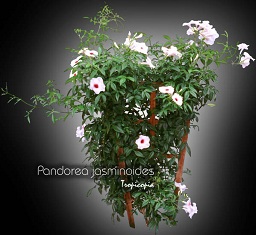Table of contents
Bower plant

Latin Name: Pandorea jasminoides
Category: Flower
Family: Bignoniaceae
Origin: Australia
Climate: Subtropical
Growing Zones: 11, 9
Care Instructions
The Bower plant (Pandorea jasminoides) is a subtropical plant that originates from Australia. This flower plant belongs to the Bignoniaceae family and is well-suited for growing in USDA zones 11, 9.
Complete Care Guide for Bower Plant (Pandorea jasminoides)
Watering Requirements
The Bower Plant, or Pandorea jasminoides, thrives best with a consistent watering schedule. During the growing season, which typically spans from spring to early autumn, it is essential to keep the soil moderately moist. Water the plant deeply once a week, allowing the top inch of soil to dry out between waterings. In hotter climates or during particularly dry spells, you may need to increase the frequency to twice a week. However, be cautious not to overwater, as this can lead to root rot. In the winter months, reduce watering to once every two weeks, as the plant enters a dormant phase and requires less moisture.
Light Conditions
The Bower Plant flourishes in bright, indirect sunlight. Ideally, it should receive at least 6 hours of light each day, but it can also tolerate partial shade. If grown indoors, place it near a south or west-facing window where it can soak up ample light. However, be cautious of direct sunlight, especially during the hottest parts of the day, as this can scorch the leaves. If you notice the plant becoming leggy or stretching towards the light, it may be a sign that it needs more exposure. Conversely, if the leaves start to yellow, it might be receiving too much direct sunlight.
Soil Preferences
The ideal soil for the Bower Plant is well-draining, rich in organic matter. A mix of potting soil, compost, and perlite or sand can create the perfect environment for healthy root development. Aim for a slightly acidic to neutral pH level (around 6.0 to 7.0). Regular fertilization during the growing season can enhance growth and flowering; use a balanced, water-soluble fertilizer every 4-6 weeks. In the fall, reduce fertilization as the plant prepares for dormancy. If planting in the ground, ensure that the area has good drainage to prevent waterlogging, which can be detrimental to the plant’s health.
Pests and Diseases
The Bower Plant is generally resilient but can be susceptible to a few common pests and diseases. Aphids, spider mites, and whiteflies are the most frequent pests that may invade your plant. Regularly inspect the undersides of leaves and stems for signs of infestation. If you notice any pests, treat them promptly with insecticidal soap or neem oil. Additionally, watch for signs of fungal diseases, such as powdery mildew, especially in humid conditions. To prevent this, ensure good air circulation around the plant and avoid overhead watering. If powdery mildew appears, remove affected leaves and apply a fungicide as needed.
Special Care Tips
To maintain the health and beauty of your Bower Plant, consider the following special care tips. Pruning is essential to encourage bushier growth and more abundant flowering. Trim back any dead or leggy growth in early spring before the growing season begins. Additionally, providing a trellis or support structure can help the plant climb and showcase its beautiful blooms effectively. If you live in a colder climate, consider bringing the plant indoors during winter or providing frost protection to prevent damage. Lastly, be patient; while the Bower Plant may take a couple of years to establish and bloom profusely, the wait is well worth it for its stunning, trumpet-shaped flowers.








